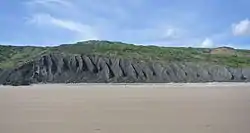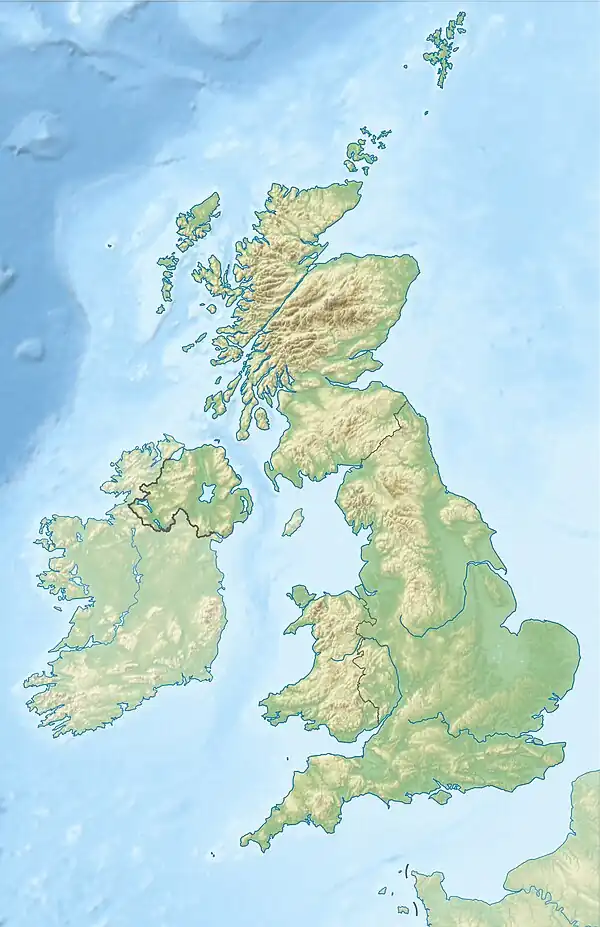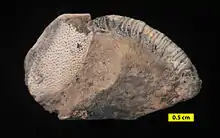| Speeton Clay Formation | |
|---|---|
| Stratigraphic range: Berriasian-Albian | |
 Speeton Clay Formation at Reighton Sands, North Yorkshire | |
| Type | Geological formation |
| Unit of | Cromer Knoll Group |
| Sub-units | Members A to D |
| Underlies | Hunstanton Formation |
| Overlies | Kimmeridge Clay Formation |
| Thickness | 100 m (330 ft) in outcrop |
| Lithology | |
| Primary | Claystone |
| Other | Glauconite |
| Location | |
| Coordinates | 54°12′N 0°12′W / 54.2°N 0.2°W |
| Approximate paleocoordinates | 41°00′S 9°18′E / 41.0°S 9.3°E |
| Region | Yorkshire |
| Country | |
| Extent | North Sea Graben, eastern England |
| Type section | |
| Named for | Speeton |
 Location of the formation | |

Meyeria ornata, a lobster from the Speeton Clay
The Speeton Clay Formation (SpC)[1] is a Lower Cretaceous geological formation in Yorkshire, northern England. Unlike the contemporaneous terrestrial Wealden Group to the south, the Speeton Clay was deposited in marine conditions. The most common fossils in the unit are belemnites, followed by ammonites and the lobster Meyeria ornata. Dinosaur remains are among the fossils that have been recovered from the formation, although none have yet been referred to a specific genus.[2]
The formation is named after the village of Speeton in North Yorkshire.
Fossil content
The following fossils have been reported from the formation:[3]
- Reptiles
- Ichthyosaurs
- Neornithischians
- Sauropterygians
- Elasmosauridae - "Speeton Clay plesiosaurian"[8]
- Fish
- Invertebrates
- Crustaceans
- Martillepas auriculum[10]
- Crinoids
- Crustaceans
See also
References
- ↑ Speeton Clay Formation - BGS
- ↑ Weishampel, et al. (2004). "Dinosaur distribution." pp. 517–607.
- ↑ Speeton Clay Formation at Fossilworks.org
- ↑ Fischer et al., 2012b
- ↑ Fischer et al., 2012a
- ↑ Norman & Barrett, 2002
- ↑ Mulder & Fraaije, 2016
- ↑ Benson & Druckenmiller, 2014
- 1 2 3 4 5 6 7 8 9 10 11 12 13 Underwood et al., 1999
- ↑ Gale, 2019
Bibliography
- Gale, A.. 2019. Thoracican cirripedes (Crustacea) from the Hauterivian (Lower Cretaceous) of Hannover, northern Germany. Proceedings of the Geologists' Association 130. 659-672. .
- Mulder, E. W. A., and R. H. B. Fraaije. 2016. New records of Early Cretaceous iguanodontian dinosaur remains from the Dutch sector of the North Sea. Neues Jahrbuch für Geologie und Paläontologie - Abhandlungen 282. 271-277. .
- Benson, R. B. J., and P. S. Druckenmiller. 2014. Faunal turnover of marine tetrapods during the Jurassic–Cretaceous transition. Biological Reviews 89. 1-23. .
- Appleby, B.; M. W. Maisch; D. Naish; R. Kosma; J. Liston; U. Joger; F. J. Krüger; J. P. Pérez, and J. Tainsh. 2012b. Correction: New Ophthalmosaurid Ichthyosaurs from the European Lower Cretaceous Demonstrate Extensive Ichthyosaur Survival across the Jurassic–Cretaceous Boundary. PLoS ONE 7(1). .. . doi:10.1371/annotation/9731f93a-c28f-4234-8fd9-c587a103b572
- Appleby, B.; M. W. Maisch; D. Naish; R. Kosma; J. Liston; U. Joger; F. J. Krüger; J. P. Pérez, and J. Tainsh. 2012a. New Ophthalmosaurid Ichthyosaurs from the European Lower Cretaceous Demonstrate Extensive Ichthyosaur Survival across the Jurassic–Cretaceous Boundary. PLoS ONE 7(1). e29234. . doi:10.1371/journal.pone.0029234 PMID 22235274 PMC 3250416 Bibcode:2012PLoSO...729234F
- Norman, D. B., and P. M. Barrett. 2002. Ornithischian dinosaurs from the Lower Cretaceous (Berriasian) of England. Special Papers in Palaeontology 68. 161-189. .
- Underwood, C. J.; S. F. Michell, and K. J. Veltkamp. 1999. Shark and Ray teeth from the Hauterivian (Lower Cretaceous) of north-east England. Palaeontology 42. 287-302. .
- Lott, G. K.; B. N. Fletcher, and I. P. Wilkinson. 1986. The stratigraphy of the Lower Cretaceous Speeton Clay Formation in a cored borehole off the coast of north-east England. Proceedings of the Yorkshire Geological Society 46(1). 39–56. . doi:10.1144/pygs.46.1.39
Further reading
- Lamplugh, G. W. 1896. On the Speeton Series in Yorkshire and Lincolnshire. Quarterly Journal of the Geological Society 52. 179–220. Accessed 27 March 2020.
- Lamplugh, G. W. 1889. On the Subdivisions of the Speeton Clay. Quarterly Journal of the Geological Society 45. 575–618. Accessed 27 March 2020.
This article is issued from Wikipedia. The text is licensed under Creative Commons - Attribution - Sharealike. Additional terms may apply for the media files.